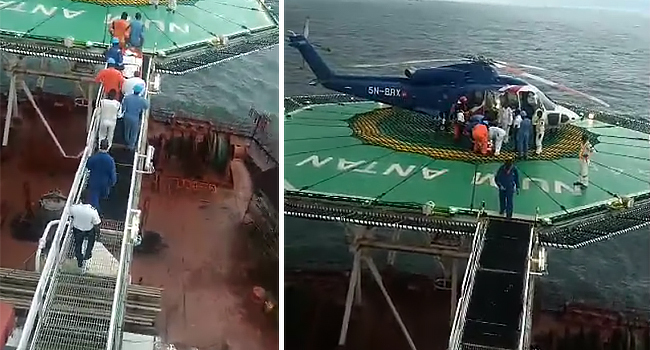The Nigerian Safety Investigation Bureau (NSIB) has reported significant challenges in recovering critical components of the Sikorsky SK76 helicopter that crashed in Port Harcourt on Thursday.
NSIB confirmed that, despite extensive search efforts, no essential parts, including the black box, have yet been located.
The NSIB Director of Public Affairs and Family Assistance, Mrs. Bimbo Olawumi Oladeji, highlighted the difficulties investigators face in the search for answers.
“Due to limited visibility and the depth at which the helicopter sank, our divers are constrained by operating conditions,” Oladeji said.
The incident involved an East Wind Aviation helicopter, identified with registration 5N BQG, which crashed into the Atlantic Ocean off the coast of Bonny Finima, Rivers State.
Eight people were on board the helicopter when it went down, and the crash site is estimated to be hundreds of meters below the surface.
The NSIB began recovery efforts immediately after the incident, deploying a team of divers to examine the area and retrieve bodies and parts of the wreckage.
Three days into the investigation, NSIB confirmed the recovery of two more bodies from the site but disclosed that essential components, including the helicopter’s Flight Data Recorder (FDR) and Cockpit Voice Recorder (CVR), had not been found.
These devices, commonly known as the “black box,” are crucial in understanding the exact cause of aviation accidents.
The search has been hampered by environmental factors that make diving and visibility challenging for recovery personnel.
Oladeji explained, “Our team is working under difficult conditions, and due to the ocean’s depth, human divers can only reach so far.”
Visibility in such underwater conditions is often minimal, making it difficult for divers to locate wreckage scattered across the ocean floor.
The NSIB has thus far been conducting preliminary sweeping operations and using basic equipment to examine accessible areas.
Diving teams began the search daily at 9 a.m., setting up and checking gear for underwater searches, but efforts are usually halted by nightfall.
Oladeji disclosed that activities on the day of the crash were suspended by 4:30 p.m. due to the loss of daylight.
“Despite our best efforts, we have yet to locate any key parts, as the conditions are very restrictive,” she noted.
To enhance recovery operations, NSIB announced plans to deploy a specialized Remotely Operated Vehicle (ROV) designed for deep-sea operations.
The ROV is equipped to dive up to 1,000 meters, far deeper than human divers can reach, and will be essential in reaching the remote crash site.
This robotic device, according to NSIB, will allow the team to conduct detailed inspections, collect data, and capture evidence vital for uncovering what led to the crash.
The ROV’s capabilities include advanced cameras, sensors, and a Tether Management System (TMS) that can operate in the harsh, dark depths of the ocean.
“Once deployed, the ROV will play a vital role by gathering critical data and enabling close inspections that human divers are unable to perform at such depths,” Oladeji stated.
The ROV’s advanced technology will allow it to perform tasks that were previously out of reach, including light manipulation, which will help in collecting valuable environmental data and assessing the wreckage.
This data will be crucial in forming an understanding of the potential causes behind the crash and will assist in providing closure to the families of the victims.
The Bureau also emphasized the importance of the ROV in capturing insights into how conditions underwater could have influenced the helicopter’s final moments.
The Port Harcourt crash has stirred concerns over helicopter safety in Nigeria, particularly in the oil-rich Niger Delta region where helicopter travel is common among workers in offshore locations.
The Sikorsky S-76 model involved in the incident is widely used in oil and gas operations, given its reputation for reliability and long-range capability.
This crash adds to a series of air incidents in the region, prompting calls for more stringent aviation safety regulations.
As investigations continue, NSIB has urged the public to remain patient, stating that complex underwater recovery operations demand time and technical resources.
“Safety investigations, especially under the sea, are delicate processes. We ask for patience as we work to provide answers,” Oladeji appealed.
For NSIB, the search for the black box and other components remains a priority.
The data from these recorders is expected to shed light on the helicopter’s last moments, including the possibility of technical malfunctions or human error.
The deployment of the ROV also underscores NSIB’s commitment to meeting international investigation standards, particularly in complex crash sites.
The Nigerian aviation industry has long faced scrutiny over its safety protocols, with experts urging increased investments in equipment and technology for accident investigations.
In response, NSIB has highlighted the need for resources to ensure thorough and timely investigations.
Oladeji reiterated NSIB’s commitment to delivering a comprehensive report on the incident once all evidence has been collected and analyzed.
“Our objective is to ensure this investigation meets international standards and that our findings bring clarity to both the families and the public,” Oladeji concluded.

